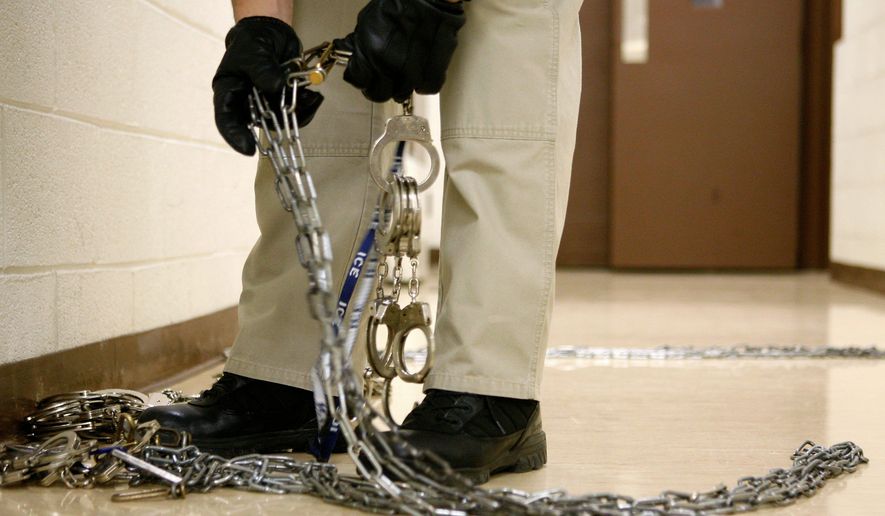Nearly a third of the 6,000 inmates whom the Obama administration plans to release early from federal prisons across the United States this month are noncitizens, officials say.
Although a lack of cooperation between local or state jails and federal immigration officials has hampered past efforts to deport illegal immigrants once their sentences are complete, officials expect this process to go smoothly.
Illegal immigrants and legal noncitizen residents, who now may be subject to deportation because of the nature of their convictions, are among a wider group set to be released early from prison sentences under guidelines recently adopted by the U.S. Sentencing Commission. The first wave of releases, scheduled for the end of the month, is part of an effort to ease overcrowding and scale back harsh penalties handed down to nonviolent drug offenders.
Disagreements over the handling of illegal immigrants have led some agencies to ignore immigration detainers issued by U.S. Immigration and Customs Enforcement, leading to the release of some inmates before they can be deported.
However, observers say there is generally much more cooperation involved in the upcoming mass release and deportation of inmates between ICE and the Federal Bureau of Prisons because both are under Justice Department oversight. That cooperation should reduce the likelihood of illegal immigrants being released before undergoing removal proceedings.
“We’ve been working with them for a while to make sure there will be a smooth transition for those who are not citizens,” a Justice Department official said on background about the releases.
According to data provided by the Bureau of Prisons, 4,131 inmates who are U.S. citizens will be among the group of approximately 6,000 to be released. Texas is expected to receive the most returning U.S. citizens, with 578 listing the state as their place of residence. Florida follows, with 295 inmates.
ICE officials declined to provide an exact figure for how many inmates they believe will be deported overall, whether officials have begun to take custody of the inmates or how many may end up in immigration detention centers awaiting removal proceedings after their release.
“ICE will review each individual’s immigration and criminal history in accordance with civil immigration enforcement priorities, which place top priority on individuals convicted of felonies, recent border crossers, and national security threats,” ICE spokeswoman Sarah Rodriguez said in a written response to questions. “ICE remains focused on smart and effective immigration enforcement that prioritizes its available resources on those who pose a threat to national security, border security or public safety.”
Immigration law analysts suspect the vast majority of noncitizens set to be released ultimately will be deported.
Edgar Holguin, an assistant federal public defender in El Paso, Texas, said his office has handled sentence reduction hearings for about 300 of the 6,000 inmates. For inmates who are noncitizens, he said, it is unlikely they will be allowed to remain in the country.
“These folks are pretty much a priority for deportation,” Mr. Holguin said, referencing ICE’s focus felons. “You are not talking about someone who was caught with a couple of cigarettes of marijuana in their pocket. This is at a much higher level.”
Many noncitizens already are going through removal proceedings while in prison, he said. For those who have not, Mr. Holguin said, the inmates typically are transferred to immigrant detention centers for processing, where they are held until the outcome of their removal hearing is determined.
“They never step on free land,” Mr. Holguin said. “These folks will be told, ’Wait here, because immigration has a bus coming for you.’”
The U.S. Sentencing Commission reported in August that, during the fiscal year, about 24 percent of more than 13,000 inmates who were granted reduced sentences under the retroactive drug guideline changes were noncitizens.
“I think it largely reflects the changes in the federal prison population, which increasingly over the years has involved a substantial number of noncitizens being caught up in drug and other offenses,” Sentencing Project Executive Director Marc Mauer said of the proportion of noncitizens subject to deportation after their release.
Although cooperation between the two federal agencies to transfer inmates to ICE custody is likely to prevent many noncitizens from release, immigration law analysts are unsure whether it will speed up the deportation process given the large number of inmates to be released at once.
Angie Junck, a supervising lawyer at the San Francisco-based Immigrant Legal Resource Center, said she would expect ICE to begin facilitating removal proceedings for inmates this month to expedite the process. She and other immigrant advocates worry that inmates may not be fully advised of their due process rights.
“There’s a high percentage of immigrants that don’t get representation in immigration proceedings,” Ms. Junck said. “Essentially, they may actually be deported straight out of the Bureau of Prisons.”
• Andrea Noble can be reached at anoble@washingtontimes.com.




Please read our comment policy before commenting.